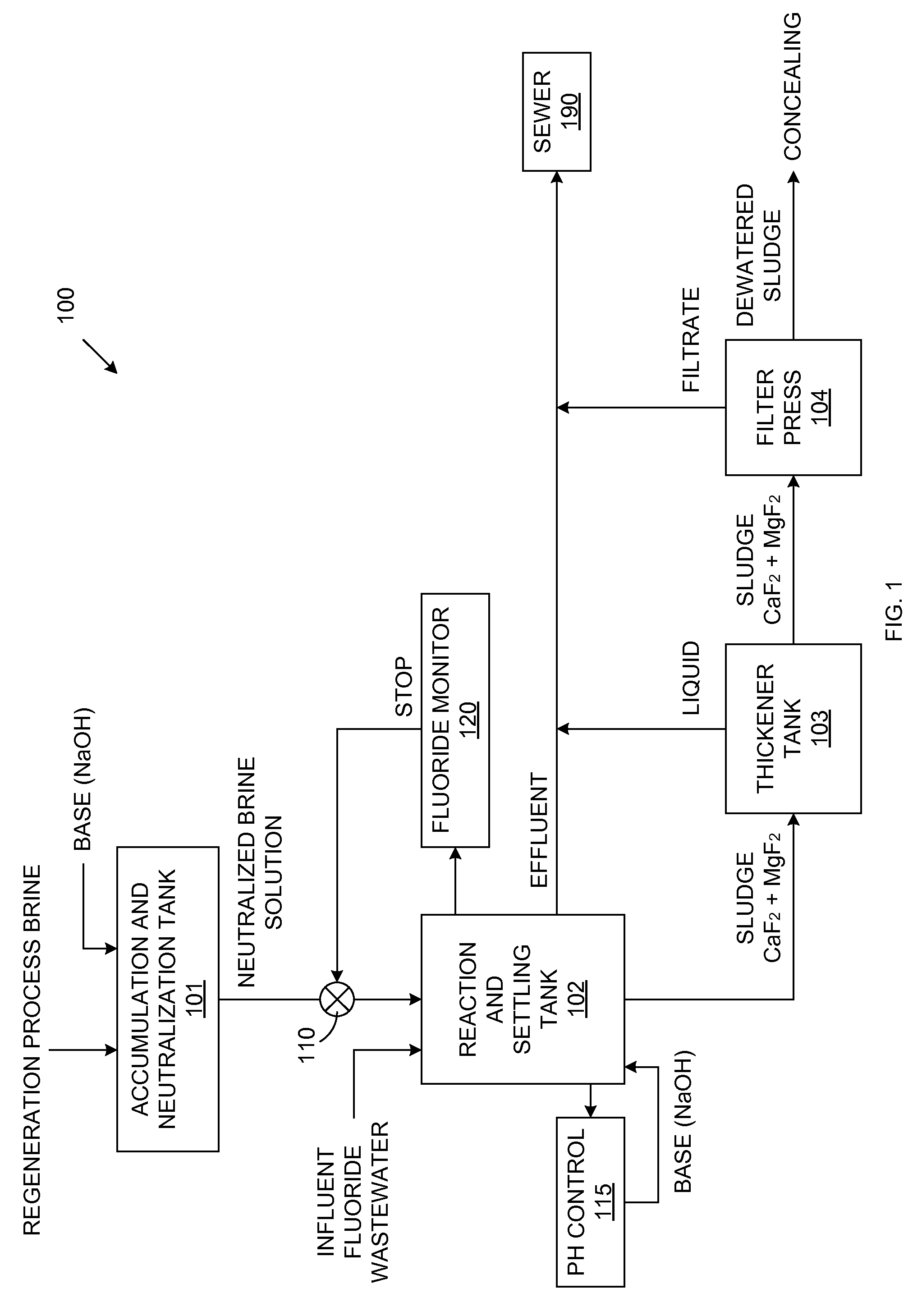Cost-efficient treatment of fluoride waste
a technology for fluoride and waste treatment, applied in water/sewage treatment, water/sludge/sewage treatment, chemical equipment and processes, etc., can solve the problems of high cost of chemicals (e.g. calcium salt), a large part of the total cost of waste treatment, and a relatively complicated and costly fluoride treatment system. , to achieve the effect of being readily availabl
- Summary
- Abstract
- Description
- Claims
- Application Information
AI Technical Summary
Benefits of technology
Problems solved by technology
Method used
Image
Examples
first embodiment
[0023]FIG. 1 is a block diagram of a fluoride wastewater treatment system 100 in accordance with the present invention. As illustrated in FIG. 1, regeneration process brine (obtained from the regeneration process of an ion exchange softener used for pretreatment of raw water in a UPW plant of a semiconductor fabrication facility) is added to accumulation and neutralization tank 101. Hydrochloric acid, which is inherently present in the regeneration process brine, causes this brine to have a relatively low pH. The regeneration process brine is neutralized with a basic agent to create a neutralized brine solution having a pH of up to about 7. In accordance with one embodiment, the basic agent added to tank 101 is NaOH. However, it is understood that other basic agents can be used in other embodiments.
[0024]Influent fluoride wastewater is pumped into reaction and settling tank 102. In the described embodiment, this fluoride wastewater contains about 30,000 ppm of fluoride, mostly in so...
second embodiment
[0028]FIG. 2 is a block diagram of a fluoride wastewater treatment system 200 in accordance with the present invention. Because system 200 is similar to system 100, similar elements in FIGS. 1 and 2 are labeled with similar reference numbers. System 200 replaces the reaction and settling tank 102 of system 100 with two separate tanks. Thus, system 200 includes reaction tank 201 and settling tank 202. Processing proceeds in the manner described above in connection with FIG. 1, wherein the influent fluoride-containing wastewater is pumped into reaction tank 201, and the neutralized regeneration process brine is then added to the reaction tank 201, while a mixer is controlled to mix the contents of reaction tank 201. During this process, pH controller 115 monitors the pH level of the mixture in the reaction tank 201. Again, pH controller 115 adds a basic agent (e.g., NaOH) to the reaction 201, as necessary, to maintain a pH greater than 9.
[0029]During the above-described process, the f...
third embodiment
[0030]FIG. 3 is a block diagram of a fluoride wastewater treatment system 300 in accordance with the present invention. Because system 300 is similar to systems 100 and 200, similar elements in FIGS. 1, 2 and 3 are labeled with similar reference numbers. System 300 eliminates the thickener tank 103 and the settling tank 202 from system 200. Processing proceeds in the manner described above in connection with FIG. 2, wherein the suspension of CaF2 and MgF2 from the reaction tank 201 is transferred directly to the filter press 104. The filtrate from the filter press 104 is safely disposed into the sewer system 190, while the dewatered sludge from the filter press 104 is properly disposed.
[0031]If the available capacity of the filter press 104 is limited, coagulants and / or flocculants can be applied to the suspension to facilitate the separation of the sludge from the filtrate. Eliminating the settling tank 202 and the thickener tank 103 from system 300 advantageously allows system 300...
PUM
| Property | Measurement | Unit |
|---|---|---|
| concentration | aaaaa | aaaaa |
| pH | aaaaa | aaaaa |
| concentration detection | aaaaa | aaaaa |
Abstract
Description
Claims
Application Information
 Login to View More
Login to View More - Generate Ideas
- Intellectual Property
- Life Sciences
- Materials
- Tech Scout
- Unparalleled Data Quality
- Higher Quality Content
- 60% Fewer Hallucinations
Browse by: Latest US Patents, China's latest patents, Technical Efficacy Thesaurus, Application Domain, Technology Topic, Popular Technical Reports.
© 2025 PatSnap. All rights reserved.Legal|Privacy policy|Modern Slavery Act Transparency Statement|Sitemap|About US| Contact US: help@patsnap.com



